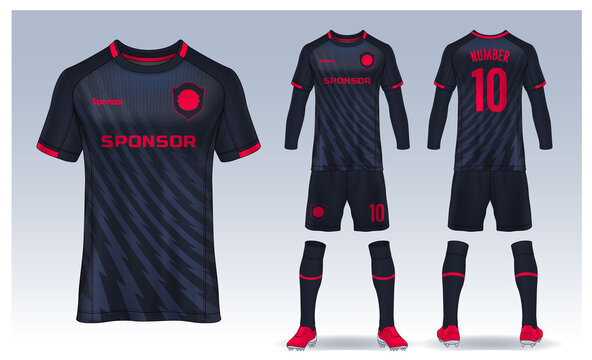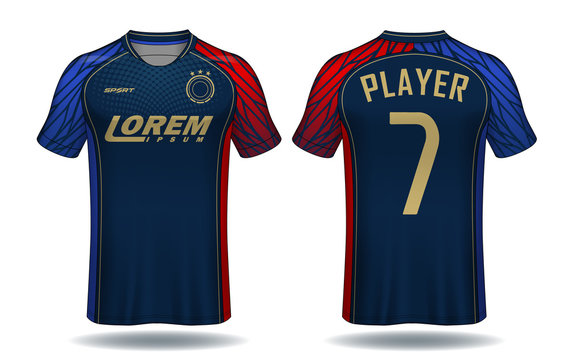There are many things to consider when shopping for soccer jerseys. Colors, Sizes, Logos, and Brands are just some of the considerations you need to make before buying a jersey. Here are a few tips to help you make the best purchase. Using this information, you can choose the right soccer jerseys ( fotbalové dresy) for your team! And don’t forget to check out our soccer gear buying guide! It is full of tips for every player to make the best purchase possible!
Sizes
To purchase a soccer jersey, women must be aware of their bust and waist measurements. You can do this by taking off your shoes and other bulky clothing. Stand with your head and heels touching the wall and look straight ahead. Then, measure from the wall to the floor, rounding your measurement to the nearest 0.1cm. Make sure to keep all this information handy for future reference. Once you know your bust and waist measurements, you can go ahead and purchase your desired soccer jersey.

The first step to choosing a soccer jersey is to find out what size it is. You can find this information by visiting an online soccer store. The best place to buy soccer jerseys is WorldSoccerShop.com. It offers a wide selection of soccer jerseys for boys, girls, and adults. It also carries customized soccer shorts. You can customize your soccer jersey with your team’s logo, personalized name, or both.
Soccer jerseys fit like regular slim or athletic tops. Some jerseys can shrink up to 10%, so you may want to go up a size or down. You should also consider the comfort level of the jersey and the durability of the fabric. Soccer jerseys are generally true to size, but there are exceptions to this rule. It’s advisable to choose the size that fits your body type and preferences. The standard deviation of jersey sizes is about 2cm.

Soccer jerseys come in a wide variety of colors and designs. They come in a classic fold over collar or more modern shoulder and side domains. You can also choose a v-neck or a crew-cut, as long as the pants match the soccer jersey’s color scheme. Remember that a soccer jersey can be worn with sneakers or shorts. If you want to match your pants and shorts, choose a soccer jersey that matches the style of your shoes.
Colors
Many colors are used in the design of soccer jerseys. Some are bold and bright, while others are plain and traditional. It all depends on the team you are buying a jersey for. To start, you’ll need to choose a color scheme. If you’re playing for your school team, it’s probably an obvious choice to use the school colors. If you’re playing for a club, however, you’ll want to choose a color scheme that fits the theme of the club. A classic color scheme might be appropriate for a team that has just formed, while simple, timeless colors will probably be good choices.
Another common color is blue. In addition, you can wear the same color scheme for your team. Blue and white are the most common colors, but blue is a popular choice for many teams. Some soccer jerseys have rhombuses or a similar pattern. For example, the away jersey of Barcelona in 2001/2002 featured a vertical blue domain. A red and blue domain was also used in the away jersey of Barcelona.
The same rule holds for the home team. While an away team may wear the same colors as the home team, a darker hue can be appropriate for a neutral team. In international matches, the away team can wear a different color. This is particularly important during the World Cup, when a lot of people watch in black-and-white. Changing colors for a World Cup match can be a difficult task, especially if the game is being broadcast in black-and-white.
Next season, high school soccer teams will be required to wear dark-colored home and dark-colored away jerseys. Traditionally, both teams wear white jerseys. However, this rule change allows hosting schools more flexibility in selecting uniform colors. The change takes effect in the 2018-19 school year. This is an important change in the design of soccer jerseys, and should be implemented before the end of the season. And don’t forget to order some jerseys.
Logos
The popularity of sponsor logos on soccer jerseys is not new. Many teams, including Manchester United, wear them proudly. Their fans are based all over the world. Whether it’s the vibrant orange and black color or the logos, you’re sure to spot it. But are they a necessary part of the game? Or are they taking it too far? Here are some reasons why. This article is not intended to be a policy statement.

A typical soccer jersey has the team’s logo front and center. These logos often represent the team’s name and/or sponsor, rather than the team’s name or number. They’re also not as subtle as those found on other types of sportswear. Despite their subtlety, these logos are still prominent enough to attract attention. Some designers go even as far as creating logos that are not too obvious.
Another way to identify a replica is by looking at the logos on the jersey. While replicas don’t have the same designs, they do have the same colors and logos. They’re also lighter than their authentic counterparts. The difference between these two types of jerseys is mainly the material used. Replicas tend to be create of breathable fabric, which allows air to circulate. Authentic jerseys are also create of heavier climate-control fabric and don’t stretch as much.

Soccer teams have been branding their uniforms for years. In fact, they’ve had sponsors since the 1950s. One Uruguayan team, Penarol, even wore logos of their sponsors to pay for their lights. While major European leagues initially resisted selling advertising space on soccer jerseys, they finally gave in to the pressure of sponsors and saw the potential revenue from such a lucrative campaign. But how do you differentiate between a soccer jersey with a logo and one that’s not?
Brands
Brands on soccer jerseys are usually unobtrusive, but some players are willing to put some effort into their jerseys to promote their brand. In this article, we’ll talk about the Fustol brand and its ad placements. Fustol is spearheaded by Nicolas Willson and Luke Scheybeler and makes soccer jerseys as simple and stylish as possible. This way, even the most casual fan can wear a soccer jersey with pride.
While some teams have sponsors, most national teams have other sponsors. For instance, the United States Soccer Federation is sponsored by Anheuser-Busch, Volkswagen, Continental, Coca-Cola, Powerade, and Tag Heuer. FIFA must honor these sponsorships because they don’t want brands competing with the official sponsor. This is not the case with many soccer players, however. These companies aren’t always the only ones putting their brands on their jerseys, though.
New Balance is one of the best-known soccer apparel brands. It’s a small company with roots in the sport and a devoted following. Mizuno, on the other hand, dabbles in a variety of sports and has made inroads into soccer. Despite its size and popularity, it remains a popular soccer brand among fans. Its soccer jerseys are also available at the official team store.

Hummel is another Danish brand with a rich history in the sport. The United Arab Emirates’ Romai Sports is another notable brand, but it may not get the recognition that it deserves just yet. A German company, Ulhsport, makes Tunisia’s official jerseys. Its soccer jerseys are not as well known as Nike or adidas, but they’re arguably the most popular. If you have any interest in purchasing soccer uniforms for your team, you’re bound to find the right brand for your team.
Fabric
There are several advantages to polyester, the fabric used in soccer jerseys. It is light, durable, breathable, and stretches to fit players perfectly. Polyester also does not retain moisture and does not shrink. Its color fastness also helps the jerseys last longer. Despite its durability, polyester jerseys are expensive. To avoid wasting money on cheap jerseys, consider buying a branded one. Listed below are the pros and cons of polyester jerseys.

First, soccer jerseys are made of water-resistant fibers that push water away from the body and onto the outside of the kit. This helps evaporate the water on the skin. Polyester is the most common material used in soccer jerseys, though other materials are used in smaller quantities. The main ingredient is polyester, although other synthetic materials are also used. Elastane, commonly referred to as spandex, is a popular synthetic material used for sponsor logos.
Secondly, soccer jerseys are expensive. Even if they don’t tear easily, it’s still important to repair small tears. To extend the life of a soccer jersey, purchase patches to prevent it from looking scruffy. Moreover, it’s easy to find patches online. Whether you buy them from soccer stores or from online stores, you’ll be able to find the right patch for your favorite team.

Third, soccer jerseys are create of fabric that shrinks when wash. While most clothes shrink when wash, a soccer jersey is no exception. If it is create of cotton, it will shrink up to 10%. Poly-cotton jerseys will shrink less, while full-cotton garments will shrink between seven and ten percent. Wool and rayon jerseys shrink less. In the end, this is a good thing for the player, but keep in mind that jerseys should be size appropriately and ideally not too loose.























![To Increase YouTube Subscribers Must Use These Service Provider [New]](https://businessleed.com/wp-content/uploads/2022/11/To-Increase-YouTube-Subscribers-Must-Use-These-Service-Provider-New-360x180.jpg)














